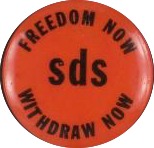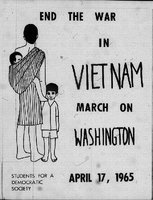The March on Washington
March on Washington to End the War in Vietnam (April 17, 1965)
Why Protest in the Streets?
In December 1964, angered and disillusioned by the Gulf of Tonkin resolution and Johnson’s escalation of the U.S. military presence in Vietnam, Students for a Democratic Society began planning a national demonstration to be held in Washington, D.C.
“We were outraged” at the president’s betrayal and by Cold War liberalism more generally, SDS President Todd Gitlin, a graduate student in political science at the University of Michigan, recalled in his 1987 memoir. Gitlin and Paul Booth, the co-leaders of SDS’s Peace Research and Education Project, considered launching a campaign of resistance against the military draft. Ultimately they decided on a resolution that demanded “American withdrawal from South Vietnam.”
After extensive debate, SDS members approved a three-pronged manifesto: “SDS advocates that the U.S. get out of Vietnam for the following reasons: (a) the war hurts the Vietnamese people; (b) the war hurts the American people; (c) SDS is concerned about the Vietnamese and American people.”
Development of MOW
Various slogans were chosen as a way to convey SDS's mission during MOW. Such slogans included: “War on Poverty--Not on People,” “Ballots not Bombs in Vietnam,” and “Freedom Now in Vietnam." Each of these slogans linked the antiwar movement to the domestic civil rights and antipoverty campaigns. This intersection played an important role in attracting diverse backgrounds to the movement.
As students from around the country arrived in Washington for the protest, the liberal editorial page of the New York Post warned that “pro-Communist” influences were seeking to turn the SDS event into “a frenzied one-sided anti-American show.” However, the concept of the March on Washington still gained support from the Faculty-Student Committee to Stop the War in Vietnam, which Todd Gitlin presented to the committee on an April 7, 1965.
Gitilin stated that the march gained the attention of over 10,000 students from universities across the United States. Additionally, he cited April 17th as the best time for it to occur since, “many people go to Washington to see the blossom festival, plus the fact that many schools take their senior class trip,” therefore it would be easy to gain the support of a wider audience.
MOW In Action
The SDS March on Washington to End the War in Vietnam, held on April 17th, 1965, turned out to be the largest peace protest up to that point in American history, drawing between 15,000 and 25,000 college students and others to the nation’s capital. Supporters of the event included Women Strike for Peace and the Student Nonviolent Coordinating Committee, showing the intersection between the peace and civil rights movements.
The day-long demonstration began with picketing outside the White House, followed by music from folk singers Joan Baez and Phil Ochs and antiwar speeches on the grounds of the Washington Monument. Bob Moses, an African American leader of the Mississippi Freedom Summer, connected the federal government’s refusal to enforce civil rights in the South to the escalation of the war in Vietnam.
Paul Booth, one of the main SDS organizers, told the New York Times that “we’re really not just a peace group. We are working on domestic problems--civil rights, poverty, university reform. We feel passionately and angrily about things in America, and we feel that a war in Asia will destroy what we’re trying to do here.”
At the end, protesters marched down the Mall to the Capitol to deliver a petition to stop the war. In its coverage of the “new generation of radicals” who organized the march, The Nation described the crowd as “veterans of the Berkeley Free Speech Movement, freshmen from small Catholic colleges, clean-shaven intellectuals from Ann Arbor and Cambridge, the fatigued shock troops of SNCC, Iowa farmers, impoverished urban Negroes organized by Students for a Democratic Society (SDS), beautiful high school girls without make-up, and adults, many of them faculty members, who journeyed to Washington for a demonstration conceived and organized by students.”
Highlights of MOW
The highlight of the March on Washington was when Paul Potter, a founding member and president of SDS, gave a speech at the March on Washington. The speech was entitled, “Naming the System.” This speech displayed a change in SDS's priorities: from dormant to more active forms of protests. The speech showed that Vietnam wasn’t sole problem at the time, but rather one problem of many. Potter critiqued President LBJ’s position on the war as it became increasingly militarized following his election. The speech explained that Vietnam was a part of the Cold War Era policy towards defending the United States against Communism. Potter questions what the result of the war will be, and if it was going to defend the freedom of the Vietnamese or if the war was for other underlying reasons. The war hasn’t helped America’s portrayal of freedom as the Civil Rights Movement starts to gain traction. Potter says that the march is unusual because the march isn’t only for Vietnam, but is a part of a movement to build a better society. Potter says in his speech:
“What kind of system is it that allows good men to make those kinds of decisions? What kind of system is it that justifies the United States or any country seizing the destinies of the Vietnamese people and using them callously for its own purpose? What kind of system is it that disenfranchises people in the South, leaves millions upon millions of people throughout the country impoverished and excluded from the mainstream and promise of American society, that creates faceless and terrible bureaucracies and makes those the place where people spend their lives and do their work, that consistently puts material values before human values-and still persists in calling itself free and still persists in finding itself fit to police the world? What place is there for ordinary men in that system and how are they to control it, make it bend itself to their wills rather than bending them to its? We must name that system. We must name it, describe it, analyze it, understand it and change it. For it is only when that system is changed and brought under control that there can be any hope for stopping the forces that create a war in Vietnam today or a murder in the South tomorrow or all the incalculable, innumerable more subtle atrocities that are worked on people all over—all the time.”
Potter’s critique of LBJ, and the policy in Vietnam attempted to enlighten protesters by challenging them to question Vietnam and the administrations actions behind the war.The words of Potter would soon become a driving force for students to find inspiration in their future actions against the war.
President Johnson Continues to Defend the War After MOW
Lyndon Johnson was in Texas during the SDS March on Washington, but the White House displayed real concern about the growing anti-war movement on the college campuses. On April 7, two weeks after the first teach-in at U-M and ten days before the March on Washington, the president delivered a major address on Vietnam at Johns Hopkins University. Johnson drew a direct comparison between the American war of Independence and the U.S. intervention in Southeast Asia: “the principle for which our ancestors fought in the valleys of Pennsylvania . . . is the principle for which our sons fight in the jungles of Viet Nam.” On the day after the March on Washington, President Johnson responded to the student antiwar demonstration, indirectly but unmistakable, with a pledge that “there is no human power capable of forcing us from Vietnam. We will remain as long as necessary, with the might that is required, whatever the risk and whatever the cost.” The president explained that he also sought peace and regretted that “the necessities of war have compelled us to bomb North Vietnam.” He even said that the events of the past week had brought a “strengthened unity of American purpose,” while rejecting the “slander and invective” of those who doubted the American mission to defend the people of South Vietnam. The U.S. military presence in Vietnam continued to escalate throughout 1965, with the air campaign against North Vietnam supplemented by the introduction of large numbers of ground troops. By the end of the year, 184,300 American troops were stationed in South Vietnam, a total that would increase to 485,600 over the next two years.
The Second March on Washington
At a second March on Washington, Carl Oglesby, the new SDS president, named the system Paul Potter ” The march was organized by Sanford Gottlieb, the political director of the National Committee for a SANE Nuclear Policy, or SANE. This March on Washington called for Americans to not only protest the Vietnam War, but to confront the issues of the civil rights and poverty within America. Dr. Benjamin Spock, co-chairman of SANE, discussed that a second protest was necessary because of the “virtual absence of debate in Congress.”
Ogelsby Responds to Potter's Question
Carl Ogelsby gave a speech that revisited the ideas of Paul Potter’s first speech “Naming the System.”
Ogelsby remarked:
“This is the action of corporate liberalism. It performs for the corporate state a function quite like what the Church once performed for the feudal state. It seeks to justify its burdens and protect it from change. As the Church exaggerated this office in the Inquisition, so with liberalism in the McCarthy time - which, if it was a reactionary phenomenon, was still made possible by our anti-communist corporate liberalism.”
Throughout the speech Ogelsby questioned the “liberals” who were at the march to protest the war and separated them into two categories - the liberals who operated the corporate liberalism system, and the liberals who were similar to the SDS protestors and members of SANE who wanted to change the system. Ogelsby sought the help of radicals and liberals to “help us find enough time for the enormous work that needs doing here. Help us build. Help us shape the future in the name of plain human hope.” Ogelsby’s reiterated the earlier speech of Paul Potter, and gave a solution to name the system that was behind the war in Vietnam and the policy that was enacted in regards to the war.
A Shift in the Movement
The March on Washington marked a change from faculty-based activism, which was seen in the first teach-in, to student-based activism. As students started to become more active in the movement, it led to protests based on other aspects of the war. The students continued activism with faculty, but gradually the activism against the Vietnam War spread nationally.
Citations for this page (individual document citations are at the full document links)
Students for a Democratic Society (SDS) Document, SDS <http://www.sds-1960s.org/sds_wuo/sds_documents/paul_potter.html>
Todd Gitlin, The Sixties: Years of Hope, Days of Rage (New York: Bantam, 1987), 177-183
“15,000 Protest Pickets Denounce Vietnam War,” New York Times (April 18th, 1965)
Jack Newfield, “The Student Left,” The Nation (May 10, 1965)
Public Papers of the Presidents of the United States, 1965, Book 1 (Washington: GPO, 1966)
America Divided: The Civil War of the 1960s (New York: Oxford University Press, 2000), 189-190
Max Frankel, “3 Whitehouse Aids Meet with Leaders: Thousands Join Antiwar,” (November 28th, 1965)
Citations: for speeches NYT 4-8-65, 4-18-65, for troops Maurice Isserman and Michael Kazin


